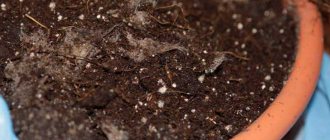Propagating ficus from shoots is a good opportunity to update a plant familiar to the interior and get new specimens for the home flower garden. This is a fun and uncomplicated event that takes little time and does not require significant financial investments.
Pruning the shoots will also benefit the mother plant, which, as it matures, loses its decorative value due to excessive elongation of the stem. We will tell you in this article how to properly take a shoot from a ficus, root it and grow a healthy plant.
Selection of timing and shoots for cuttings
It is important to carry out any interventions in ficus tissue taking into account its biological characteristics. This is the main condition on which the restoration of the mother plant and the degree of rooting of the cuttings depend. The quality of planting material and correct planting determine the resistance to disease and temperature conditions of the new plant.
Ficus transplant at home
The event is planned for early spring, when the intensity of sunlight increases. During this period, increased metabolism and formation of phytohormones occur in the ficus tissues, which stimulate the growth of new roots. After planting the ficus in March or early April, the plant will have enough time to strengthen its roots until autumn.
An important condition for the rooting of shoots is the complete ripening of the shoots. This process can be stimulated artificially. To do this, 15 days before cuttings, stop watering the ficus and moisten the plant with an aqueous solution of charcoal (20g/10l).
Depending on their location, ficus shoots have different properties. The closer the shoot is to the growth point, the better the stage changes occur in them. This means that planting material from the top of the plant will take root, develop and bloom faster.
Therefore, for rooting, it is not uncommon to choose the apical shoot, or, in extreme cases, shoots from the middle part of the ficus. A prerequisite is a healthy leaf bud on the top of the cutting.
How to care for ficus at home
Although ficus is unpretentious in care, it, like any other indoor plant, requires a lot of care and love.
Soil selection
Young plants need light, air- and moisture-permeable soil, consisting of leaf soil, sand and peat in equal quantities. Adult ficus plants require dense soil; for this, turf soil, humus or compost are added to the soil. If you don’t have the time or desire to prepare the substrate yourself, you can purchase it at the store. Do not forget that purchased soil must be disinfected. To do this, pour boiling water or a hot solution of potassium permanganate onto the soil.
For good growth you need light and nutritious soil.
Lighting and humidity
Ficus is a light-loving plant, so it is better to grow it in a well-lit place; the light should be diffused and bright.
With a lack of lighting, the leaf plate becomes smaller, and the shoots begin to reach for the light, which greatly affects the decorativeness of the plant.
The best place for a flower is the eastern or western side, protected from drafts. There are varieties that grow well in partial shade; sunlight is contraindicated for such plants. For the growth of ficus, maintaining air humidity is also important. It should be no less than 50% and no more than 70%. In hot summers, the flower must be sprayed and given a warm shower. The water should be settled, soft and at room temperature.
For full development, the plant must be sprayed once a week.
Temperature
Since the plant comes from hot countries, it needs an air temperature in the range of 25−30°C in summer and 15−20°C in winter. In a cold room, the plant stops developing and sheds its leaves. Ficus does not tolerate sudden changes in temperature and hypothermia of the soil.
The warmer the air, the more light the ficus needs.
Watering rules
Ficus does not tolerate both overwatering and underwatering. When the soil is oversaturated with moisture, the foliage loses its color and falls off, and the root system may rot. If it is underfilled, the leaf curls, dries out and also falls off. In order for the plant to feel comfortable, you need to know a simple rule: watering should be carried out only when the earthen ball dries to a depth of 4 cm, and for adult plants drying to a depth of 8 cm is acceptable.
Watering is carried out with warm and settled water
How to feed a plant
During the growing season, ficus requires feeding for rapid growth. In spring and summer, nitrogenous fertilizers are used to quickly increase green mass.
If a plant sheds its leaves, then fertilizing will help it to rehabilitate faster.
Suitable fertilizers include: mullein, infusion of ash, nettle, as well as ready-made mineral fertilizers “Ideal”, “Gumisol”, “Ficus”. Application frequency: in summer – once every 10 days; in winter, the flower does not need fertilizer.
Pruning and crown formation
Caring for a ficus, in addition to watering and feeding, also includes pruning. This procedure is carried out to give the crown a certain shape, rejuvenate the plant and prevent diseases.
Pruning is the main thing in plant care
Before you start pruning, you need to decide on the timing. Spring is the time when a plant’s branches can be pruned to form a crown. After this procedure, the plant will become lush and begin to produce young leaves. Autumn is an unfavorable time for pruning. Since during this period the plant begins to use the accumulated nutrients, and when pruning, the owner of the flower deprives it of the necessary substances that help the plant to winter favorably.
How to trim a ficus correctly (video):
Ficus transplant at home
Flower transplantation is carried out annually in spring. To do this, you need to prepare a large pot, nutrient soil, and drainage (expanded clay, pebbles or broken bricks).
How to properly transplant a ficus at home:
- We carefully remove the flower from the pot along with the earthen lump.
- We clean the root system of old soil; to do this, the plant is kept in a container with water for several minutes.
- Fill the bottom of the pot 2-3 cm with drainage.
- We fill in the first layer of soil and compact it. Next, install the flower and gradually add soil so that no air cushion is formed.
- Water the transplanted plant abundantly.
The first fertilizing is applied no earlier than a month after planting.
Ficus transplantation is carried out every five years
Caring for a flower at home in winter
Ficus care in winter is significantly different from summer care.
Temperature-humidity regime . Although the plant is thermophilic, in winter the air temperature must be lowered to 15°C. The upper limit is 20°C. If the temperature is high, the plant will begin to shed its leaves. You also need to maintain air humidity. To do this, install an air humidifier or a container of water next to the ficus, spray it and take a warm shower.
Watering . With the onset of autumn, watering must be gradually reduced. In winter, irrigation is carried out once every 1.5–2 weeks with warm, settled water.
When watering with cold water, the plant's root system rots, which leads to its death.
Lighting . The plant also needs a lot of light in winter. To do this, additional artificial lighting is installed above the flower. Lack of light causes foliage to drop and growth slows.
Ficus needs a lot of light and warmth
Fertilizers . If the ficus grows without additional lighting, there is no need to apply fertilizer. With additional lighting, the flower will need feeding, but with a dosage half as much.
Proper care (video):
Preparation of the process
To cut the shoot you will need a sharp garden knife and activated carbon powder. The procedure is not carried out with scissors or a blunt instrument, especially since the flower shoot should not be broken off. This greatly disrupts the structure of the cambium, and as a result, the nutrition of the plant.
How to root a flower shoot without roots? The ficus shoot should be 12-17 cm in length with 2-3 leaf internodes. How to take a shoot from a ficus? The cut is made 0.5 cm below the internode at a slope of 45°C relative to the stem. After this, the wounds of the mother plant are treated with activated carbon.
Ficus grown from a shoot
Cuttings of the cuttings are washed in running water. In this way, the milky juice is washed off, which can subsequently create a dense crust and clog the stomata on the cutting. This greatly interferes with root formation.
For ficuses with large leaves (rubber, lyre-shaped), they are cut in half and rolled into tubes, tied with a soft cord. This will help avoid excessive evaporation of moisture and relieve the plant of the burden of feeding a large number of cells.
In small-leaved plant species, only the lower leaves are trimmed. Leaves play an important role during rooting of cuttings. They supply the plant with hormonal, energy and plastic substances that are formed during the process of photosynthesis. Therefore, you should not greatly reduce the green mass.
After this, the cuttings are kept in warm, settled water for 2 hours and dried until a thin film forms on the sections. During wilting, excess moisture evaporates, which significantly reduces the risk of rot.
To stimulate the rapid formation of roots, cross-shaped cuts are made with a knife on the cutting. This increases the wound surface on which callus tissue will form - the basis for the formation of new roots.
How to propagate ficus by shoots (air layering)
Sometimes large-leaved ficus is easiest to propagate by air layering. Especially if the plant is old. This method is not easy and is recommended only for experienced gardeners:
- On a thick branch we find a point where the branch will not bend much. Otherwise it will simply break. Remove the sheet and make a vertical cut.
- To ensure that the cut is always slightly open, we place a match in it. Then we wrap a small amount of moss around the cut and secure it with threads and film, leaving holes for air circulation.
- Next, we take care of the ficus as usual for 3-4 weeks. We periodically check the location of the incision. When the moss has grown roots, remove the film, cut off the cuttings and plant it in a separate pot.
Ficus benjamina can also be propagated by layering, in which the stem has become woody. Most often, old ficus trees are propagated this way. But the technology is slightly different from the one described above.
Planting a shoot in the substrate
How to plant a ficus sprout? To root the cutting, you need to prepare a container 10 cm high. It is disinfected with a 3% formaldehyde solution. It is better to mix the substrate a few days before planting the cuttings. During this time, it is structured and saturated with moisture.
To do this, mix the components:
- peat 40%;
- river sand 40%;
- vermiculite 20%.
A ficus shoot that has a root
After this, pour with boiling water or a 1% solution of potassium permanganate.
Before planting the cuttings, the sections are treated with “Kornevin” (growth stimulant) or crushed charcoal. Planting material is buried to the level of the lower node in a moist substrate.
How to grow a ficus shoot? For rooting, ficus cuttings require high humidity of at least 85% and high temperature +28°- +30°C. This can only be achieved in a mini-greenhouse.
To do this, you will need a transparent plastic container of suitable volume, in which you need to make 8-10 small holes with a needle. Cover the cutting with it and place it in a well-lit place.
The ideal option is south-facing window sills with radiators located below, which will provide the required temperature.
During the rooting period, the greenhouse is ventilated twice a day for 15 minutes, morning and evening. Complete formation of ficus roots occurs on average after 30 days. This can be judged by the appearance of new leaves. During this period, ventilation is done every day, gradually increasing the time and accustoming the plant to indoor conditions.
Rules to help you choose a healthy shoot
If you want to independently separate a shoot from a ficus, then you need to choose only strong and healthy plants, for example, you can take a cutting when cutting the crown of an adult ficus. However, before doing this, you need to make sure that the selected branch has leaves. The length of the process should be at least 10-15 centimeters. All actions must be performed with a sharp knife or blade. The cut must be made at an oblique angle. And under no circumstances should you use scissors, much less break a twig, as you will only injure the plant, which will result in delayed rooting and further development.
If you have chosen a large-leaved species for cultivation, then in order to grow a flower at home, it is enough for the cuttings to have 3-4 leaves. In this case, it is advisable to trim the lower one, since a large number of leaves will contribute to excessive evaporation of moisture. When growing small-leaved ficus, the lower leaves also need to be trimmed, but their number can be more than 3-4.
After the procedure of trimming the leaves and the shoot itself, the plant can release white sap. If you don't wash it with water, it dries out very quickly. This cannot be allowed. Therefore, after the shoot is cut, the juice should be washed off with warm water or placed in a container with water for several hours. It is also recommended to treat the cut area with charcoal.
Before planting a ficus shoot, you need to dry it or simply change the water several times. There are two methods of planting: cuttings from roots and without them.
Features of rooting cuttings in water
For this event you will need a glass container with a dark tint. This will limit the access of sunlight to moisture, which promotes the development of algae (water blooms). If the container is transparent, it is wrapped in thick paper.
Ficus shoot
For rooting ficus, use filtered or boiled water, slightly warmer than room temperature. A piece of charcoal or activated carbon is added to it. It is an excellent antiseptic and stimulator of root formation.
Only the stem of the cutting is immersed in water. Water getting on the leaves leads to rapid rotting. To maintain the plant at the required level, you can cut a circle of foam with a hole for the stem in the middle. It is placed on the surface of the container and the end of the cutting is lowered into the water through the hole.
A mini-greenhouse with periodic ventilation is also equipped for the plant. Add water as it evaporates. After 5-10 days, the formation of white growths - callus tissue - can be observed on the cut of the cutting. After the roots reach 2-3 cm, the cuttings are transplanted to a permanent place of development.
It is not recommended to keep the plant in water longer. Ficus roots develop slightly differently in water than in soil. They are covered with fluffy root hairs, which, when placed in a substrate (in a drier environment), gradually begin to die off. Therefore, it is important to transplant the cuttings before the roots develop to a large volume.
Types of indoor ficuses - names and photos
In nature, there are 1,500 varieties of ficus, but no more than 20 species are grown at home, which differ in color and shape of foliage, as well as in maintenance and care. The most common ones include the following.
Benjamin. A beautiful, unpretentious plant that will complement any interior. It gained its popularity due to its flexible branches, from which you can create various shapes, as well as grow a bonsai tree. Benjamin needs a timely haircut, which makes the crown look full and well-groomed. But there are also disadvantages:
- the plant sheds its leaves in the autumn-winter period;
- afraid of drafts and sudden drops in temperature;
- does not tolerate direct sunlight. If the plant stands in full sun, the leaves fade and become thinner;
- If pruning is not carried out, the branches stretch out and the plant loses its decorative appearance.
Benjamin is one of the brightest representatives of the rubber
plant . This species has a varied shape, color of foliage and shoots. The plant does not require care, so it is loved by inexperienced flower growers and people who are often on the road. Advantages of this type:
- grows in any climatic conditions;
- does not require abundant watering;
- Grows anywhere and in any light.
The leaves of the rubber ficus are dark green or have a golden edge.
Rubber-bearing ficus is a common potted crop.
Transplanting a rooted ficus
When choosing a pot for a ficus, you focus on the size of the roots that will develop in the first year. If the volume is too large, water will stagnate in areas of the substrate undeveloped by the plant roots and pathogenic microflora will develop. Therefore, the diameter of the pot should be 2 times smaller than the ficus crown.
A drainage layer of expanded clay is laid at the bottom of the pot, which occupies 15% of the total area. Young ficuses are more sensitive to the quality of the substrate; for them, mix in equal parts:
- humus;
- peat;
- washed river sand.
For greater looseness, add a handful of fine expanded clay or charcoal to the components, which will absorb excessive moisture. The finished substrate is disinfected with a solution of potassium permanganate or boiling water.
Adult ficus for home decoration
The pot is filled 2/3 with the substrate and the ficus roots are placed in it, gradually sprinkling it.
At the same time, the formation of voids is controlled, which can subsequently lead to rotting. The soil is compacted and watered with water at room temperature.
After planting the cutting in the ground, it is kept for 2-3 days in a shaded room. This is necessary for the roots to adapt to the substrate. After this, a permanent location is chosen based on the species requirements.
Subsequent ficus transplants up to 4 years are done annually using the transshipment method. Older plants are replanted every 2-3 years. In the intervals between transplants, a layer of substrate up to 5 cm is replaced with more nutritious soil.
Expert opinion
Yulia Yurievna
I have a large garden and vegetable garden, several greenhouses. I love modern methods of cultivating plants and mulching the soil, and I share my experience.
Ask a Question
Video about planting ficus
In addition to our article, you can watch a video on how to plant ficus at home.
dekorplants.ru
From my mother, almost as a family legacy, I inherited a ficus sprout (this is how she responded to my desire to plant this pretty flower). I had to gather a lot of information to understand how to plant a ficus sprout without roots, because the main problem, in principle, was that this sprout needed to be rooted somehow, and in order to force the ficus to start forming roots.
Having turned to my mother for advice, I decided to clarify how she would see growing ficus from a shoot in the future and how to plant it later. Clear instructions were given to place the cutting in water, waiting for roots to appear later. The system somewhat reminds me of growing aloe leaves for further planting in the soil mixture, because they do not have a root system at all. I think that this is the best option for a ficus shoot rather than planting it in the ground right away, thinking whether it has sprouted or not, but in water you can easily and clearly evaluate all its shoots, and also adjust the planting time if we see that the plant is still not developing .
The water should be filled with regular charcoal or charcoal to speed up the germination process. The main thing to remember is that the lower leaves, if any, although they should normally be there, should not touch the water - only the lower stalk is in the water, from which the roots will grow.
Of course, there will be less and less water in the container in which we are germinating the shoot, so we gradually pour water there as it quickly evaporates.
After the roots have sprouted, the entire formed system can be transferred to open ground. The ficus mixture at this early stage should be half loose and also half very nutritious. But the lightness of the soil is a more important point, because in a heavy substrate the ficus shoot simply will not develop further. By the way, these also apply if you grow a shoot without roots directly in the soil mixture. Next, we create greenhouse conditions for the shoot, placing it either in a greenhouse or under a glass jar. Both elements can be replaced with simple glass or plastic film.
The shoot needs a little over two weeks to form normally, to develop and begin to germinate well, stretching upward just like an adult ficus. My shoot sprouted very quickly in water, and then took root in the soil mixture so well that I didn’t have to rack my brains about how to feed it and so on. I think that this is most likely due to the characteristics of the ficus itself - this is such an active plant - as well as the correctly chosen germination method: first water, and then soil, which helped me plant a ficus shoot without roots and without long-term painful problems.
The ficus, of course, will need some more time to get used to the conditions of the environment, apartment or house in which you plant it. In order not to ruin the ficus, it is better to scour the portals in search of how to properly place the ficus in the house and how best to care for it.
How to choose the right pot
How to properly plant a ficus in a pot - first of all, it must be suitable, in accordance with the size of its root system. For young shoots, the best option is when the roots do not reach the walls of the container by about two centimeters. Too large a pot can lead to stagnation of liquid and rotting of the roots.
In order to correctly place the ficus, planting should not be carried out in a pot with no drainage holes, otherwise the same thing will happen to the roots as with large container sizes. There will be no outflow of liquid, and they will simply rot and the plant will die. Therefore, you only need to choose a pot with holes at the bottom, and if you really like the pot, you can make holes in it yourself, using a hot screwdriver.
The next rule is based on the size of the roots of the tree: ideally, the container should be only 2 cm wider.
It is best if the pot is made of plastic, because the powerful root system of the plant can eventually grow into the walls of the clay container. This is fraught with traumatization during transplantation. Thus, the size and material of the pot also matter, and a healthy grown ficus benjamina can be achieved partly thanks to them.
Pruning rubber ficus
Being a more decorative ficus, this species is more compact and created specifically for home conditions. Most often its height reaches ten meters. It is very important for the owner to know how to properly prune the rubber-bearing ficus so that this variety begins to look more miniature and graceful.
This instance allows you to create any shape. Before pruning the rubber ficus, you need to familiarize yourself with the pruning rules and adhere to them. Even a novice florist can cope with this task. As a result, knowing how to prune a ficus beautifully, you can turn a nondescript flower into a unique home decoration.
Ficus benjamina must be pruned using new shoots that grow from the buds. There are only two such places on the flower - the apex and the lateral bud, which is located in the axils of the leaves. The apical bud is responsible for the rapid upward growth of the plant. At the same time, it is much ahead of the lateral buds, which develop too slowly. Sometimes axillary growth points do not show signs of activity and are in a dormant state. Therefore, it is important to know how to prune a ficus so that it bushes and looks more magnificent.
Removing the top bud will give the flower a chance to develop side shoots, which usually begin to grow in a variety of directions. After such manipulation, the plant can begin to change its crown.
Many beginners in floriculture, starting to work with ficuses, are interested in whether it is possible to trim the top of the ficus so that it stops growing into one shoot. Experts say that if other species fork after this procedure, then the rubber ficus can continue to grow. Before pruning a large ficus, you need to find short internodes on its shoots. A horizontal cut should be made just before the bud if the shoot is green and young. A plant with a hardened trunk is cut in the same place, however, at an oblique.
You should not leave tall stumps, which not only do not look aesthetically pleasing, but can also become a place for fungal diseases to accumulate and multiply.
Step-by-step instruction
The best time to plant a ficus shoot is spring; summer sunny weather is better for rooting and subsequent adaptation of the plant. If the shoot is planted in the fall, the young plant will not have time to prepare for winter frosts and may simply die.
Before planting a ficus benjamina shoot, you need to select a cutting 10 centimeters long, which has previously been rooted into the ground. Further, all actions occur in several stages:
- Prepare all the necessary materials described earlier.
- Place drainage at the bottom of the pot to avoid excess moisture in the soil, since a large amount of water can lead to rotting of the roots.
- Fill the pot with the prepared earthen mixture, then make a small depression in the center, about one and a half to two centimeters high.
- Place the rooted cuttings in this hole and sprinkle a little with the mixture, then water generously.
Now the ficus can be placed on a windowsill or a special flower shelf, and the plant also needs special care to keep it healthy.











